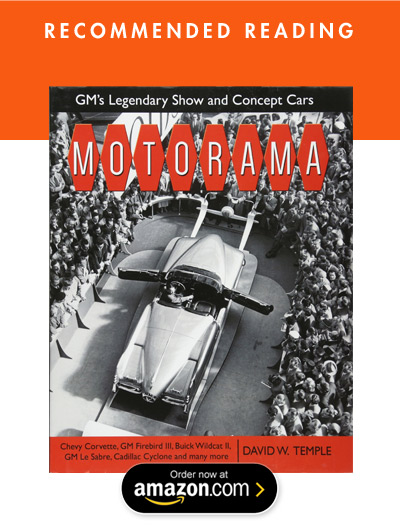
Carroll Shelby receiving a drink of Champagne from the trophy after winning the
1956 race at
Palm Springs. Runner up,
Phil Hill, is standing by. This is Howard's all-time favorite photo. "
I thought my shot was great especially after I saw the almost identical photo in an auto magazine taken by a photographer standing right next to me. What were the chances I would be standing in the right spot at the right time!" Photo courtesy of
Howard Miereanu.

Howard's car design from above pinned up outside along with the work of seven other designers for all to see and each student to talk about his design. "
You really got to see the thinking that each student put into their design," Howard told us. Photo courtesy of
Howard Miereanu.

A construction photo of the
1958 MacMinn Le Mans Coupe by Howard. The car stands as a testament to the design prowess of
Strother MacMinn, a revered figure in automotive design and education. Miereanu, a former student and friend of MacMinn, recalled, "
Mac was not only my instructor while I was a student at ArtCenter studying auto design, he was a great friend over the years." He spoke of MacMinn's unwavering commitment to his students, emphasizing how he would encourage them to think creatively and challenge the conventional boundaries of automotive design. These mentorship sessions, often extending to auto shows and intimate gatherings, allowed students to dissect and analyze the latest in automotive trends, fueling their passion and curiosity. Photo courtesy of
Howard Miereanu.

Another photo of the
1958 MacMinn Le Mans Coupe that Miereanu took after Mac had the
Fiberglass body finished. "
It was one of the most exciting times for all of his students to see a design come from a sketch to fruition," Miereanu recalled, adding that the strips were only tape. Photo courtesy of
Howard Miereanu.

Howard fondly remembered the excitement that surrounded the creation of the
1958 MacMinn Le Mans Coupe. "
It was one of the most exciting times for all of his students to see a design come from a sketch to fruition," he noted. The unveiling of the finished
Fiberglass body was a pivotal moment, not just for MacMinn, but for all those who had been part of the journey. Miereanu's personal collection of photographs and 16mm movie footage from Mac’s car at
Riverside Raceway stood as a testament to these memories. Photo courtesy of
Howard Miereanu.
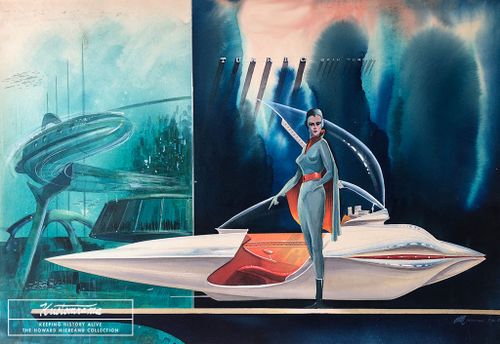
Tuareg Gran Turismo! This was the very first project Howard was given when he started at
GM's Orientation Studio. The year was
1959, and they said, "
let your imagination out of the box." Howard decided to do an underwater vehicle for an amusement park like
Disneyland. "
We all had a great laugh, but the shape of the car did get a discussion started on what the future styling of automobiles could look like." Photo courtesy of
Howard Miereanu.

Howard believed this was one one of his first designs created circa
1959, "
as a pledging in the orientation studio. It was also the first time we got to go from a rendering to a 3-D clay model." Photo courtesy of
Howard Miereanu.

The clay model for the sporty coupe above. "
I was trying my hand at sculpturing the sides of the vehicle and then transferring the actual details to the 3-D car in clay. Because designers were not union members, we were not allowed to touch the clay model but to direct the molder as to what we wanted."

"
The fun part of this project was that I had designed the front and side of the car…but what to do about the rear. Once the clay molder got started, I was able to give instructions to him! I think it worked out okay! The project was to design a sporty 2-door coupe. If you notice, there doesn't seem to be a trunk lid. If you look closely, there is a cut line on the rear fender. My idea was to have the rear fenders lift like gull wings exposing a trunk area from both sides, much like saddlebags on a horse. As for door handles, we thought about electronic push buttons on the key fob."
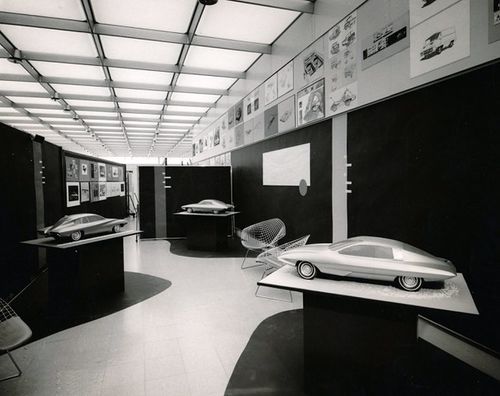
A photo taken in the
GM Orientation Design Studio circa
1959-
1960. This photo shows one part of the very large studio that Howard was in when he first came to
GM. "
The 3 cars shown are scale clay models of mine."

Howard believes he did this design in
1959, while he was still in Orientation Design Studio, before being placed in one of the
Advanced Design Studios. "
Lucky me! That was the "honey pot" of a studio to be sent to." Photo courtesy of
Howard Miereanu.
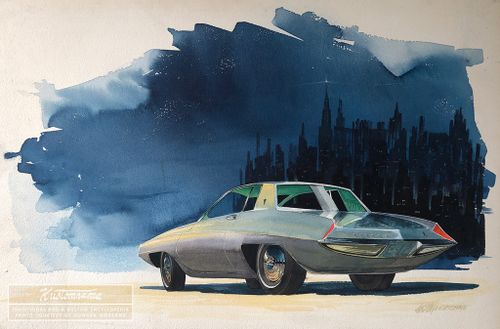
In
1959 Howard was just starting at GM in the Orientation Studio, and one of his first assignments was to design a 2-door, 4-place sport coupe that could be used for Buick. "
In 1960 Buick actually displayed a concept sport coupe at the GM Display at the auto show. My design was liked by my fellow designers, but it was never used. A great lesson for a new designer." Photo courtesy of
Howard Miereanu.

This design was another one of Howard's designs from his time spent in the "Orientation Studio" at GM. "
The project was to design a vehicle that could be adapted to future Buick or Oldsmobile automobiles. A sporty looking 2-door coupe with its low long lines, the partially covered rear wheel, and unique window treatment were well excepted. The bright yellow color was also to give the design a unique and sporty look." Photo courtesy of
Howard Miereanu.
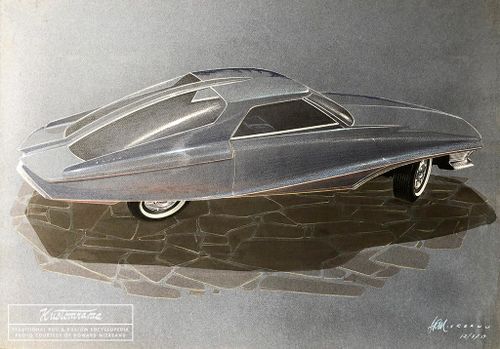
A Buick design proposal that Howard made in
1959. "
As far as I can remember this split-window coupe was designed while I was still in the orientation studio just before being assigned to one of the advanced design studios. It was not for any particular division, but I think the design staff at Corvette took a close look at it. I later was put into the Corvette studio, as a design team member, for a short period of time." Photo courtesy of
Howard Miereanu.

Dated November 5,
1960, Howard had been in the Cadillac studio for about a month when he made this design. "
As I remember, the project was to design a low profile sport coupe. That was the reason for the front fender blisters. The headlights would have covers that would protrude automatically, and I designed the wheel covers to have mock knock-offs to give it a sporty look at per the European sports cars of that time period. I loved my front window treatment which gave the car a forward motion look. The low roofline worked well, and I had designed a slight rain guard along the edges running above the door opening. Overall this was a fun project, and I love the look of this car!" Photo courtesy of
Howard Miereanu.

This is one of Howard's favorite designs. "
In 1960 I was transferred to the Buick studio and was assigned to a team that was working on the design of a sports coupe for the 1964-65 line of cars. This was just one of hundreds of designs renderings that was proposed. At that time period, nobody had been thinking about sculptured sides and air scoops, but the shape of the line from the top of the front fender well that goes straight back and then curves down to the front of the rear wheel comes close to sculpturing. The use of rear fender skirts gave the car a more unbroken visual look. We thought more about long, low sleek looking images." Photo courtesy of
Howard Miereanu.

1960 Orientation Studio. "
The project was to design a small street car that could also be a small track racer," Howard told
Kustomrama. "
We based the size on the new Corvair two-door coupe, which was the perfect size. The idea of this type a vehicle was due to ti the fact that In 1957 Zora Duntov had pushed GM to embark on the development of the Corvette into a full-fledged sports-car. Our idea was that a small street car would be perfect for the amateur racer and could take this car and have fun racing on the small local tracks along with MG’s, Triumph sports cars and such. Great idea and it was a fun project, but only an experiment for the new designers. All this was kept in our studio and never went any further." Photo courtesy of
Howard Miereanu.
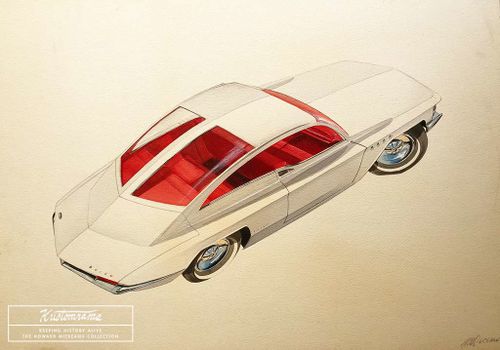
This split rear window Buick design was from early
1961, as part of a 2 door, four places sporty coupe project. "
This was the second design I came up with. I kept the front fender port holes and revised my first car's design for the split window. We all tried many different concepts to give the car a faster look. I always loved a fastback, and the split window was a perfect match. Also, the belt line continued from the front and around the sides of the car and disappeared just behind the rear fender well. The window treatment started about 18 inches ahead of the front window as a low fin which continued on the door and the rise to the back window to house the recessed door handle. I always loved this design, and it was well received along with any number of designs submitted by the design group." Photo courtesy of
Howard Miereanu.

An early proposal for a
1962 Buick Concept Car that Howard did. "
The pop up driving lamps looked good," Howard told Kustomrama, "
but were not the best idea being placed in the bumper. But as designers, we tried all sorts of outlandish things. It was set up for a smaller sports vehicle. It never went any further than a sketch." Photo courtesy of
Howard Miereanu.

This was one of the last designs Howard did before he left
GM at the end of
1963 and came back to sunny
California. "
57 years ago is a long time to remember many details but this one was fun working on! It was the fall of 1963 and I was on loan from my Advanced Design Studio and transferred to Chevrolet. The project they were working on was a new smaller car called…Camaro. GM was hoping to introduce it in 1966, which they did. Their idea was to give the public a car to go up against the very successful Ford Mustang. The two-door coupe pictured was just one of many designs submitted and many many others by the Chevy staff. The design shown here is a 2-door small size style 4-place coupe. The sculptured side actually runs all around the car, from the front grill detail to the rear tail light grouping. The unique design of the front grill, wraps from the front of the hood down below the lower part of the front of the car. The window detail line gave a new place to show the car's name! Actually a full-scale model was made of this design along with 3 others. Unfortunately, this design was not selected. You win some… you loose some!" Photo courtesy of
Howard Miereanu.
Howard R. Miereanu is a well-known graphic designer. With degrees in industrial design & graphics from the Art Center College of Design, Howard’s experience is wide-ranging; from an exterior automotive designer at General Motors (1959-1963), back to Los Angeles he joined a local furniture manufacturer as head designer and created a line of office furniture, moved on to be Senior Partner at Advertising & Sons (a boutique advertising agency in Beverly Hills), and finally to owner and founder of HRM Graphic Design (a Woodland-Hills-based graphic design studio specializing in packaging, corporate ID).[1]
Howard was born in New York City, New York in 1936. He moved to Los Angeles, California in 1947, and has been interested in cars, design-wise, for as long as he can remember. While attending Alexander Hamilton High School in Los Angeles, he received two summer scholarships to ArtCenter that sent him in the direction of the auto design field. "While at ArtCenter, we all knew Syd Mead, and Syd always gave me pointers on illustrating people, which I was not very good at," Howard told Sondre Kvipt of Kustomrama in 2022
Howard graduated from ArtCenter in September of 1959. "When I graduated from ArtCenter, there were ten students in automobile design and three in product design. Only GM and Ford came out that year to interview prospective designers. George Angersbach, one other designer, and myself were the only designers selected by GM." When Howard arrived in Detroit with his just-married wife, they found an apartment, and their neighbor was Syd Mead!! "After a few months in the orientation studio, George was moved to the Chevrolet Interior studios, and I was selected to a new home at the Advanced 4 Studio." Howard was selected to be placed in an advanced design studio instead of any of the production studios at GM. "We designed many of the show cars, now called concept cars. I also was loaned out to a few production studios for a few months at a time to get "fresh blood" into their design work, Buick, Cadillac and Corvette, where the 63 split-window came from. " Two winters were enough for Howard, and he decided to throw in the towel, and move back to California.[1]
Howard recently relocated from Woodland Hills to San Juan Capistrano to relax in the beach area and continue working on the creation of his assemblages. Each one has a different theme and overall look. Howard also does commission pieces for individuals that are looking for just that special custom assemblage to give as a gift or dress up their home or office. He still loves auto design, and can be found at car shows such as the Pebble Beach Concourse d’ Elegance. "I’ve been attending this fantastic show for years and I’m a big fan of Ferrari. A few years ago I started a collection of digital photos of Ferrari road, competition and F1 cars, showing front and rear 3/4 view. I now have virtually photos of every Ferrari ever made. Each one is listed with the year, model and coach maker/designer." Howard has been kind enough to share some designs from his collection with Kustomrama, so we all can get a glimpse into the creative mind of the young designer.[1]
References
Kustomrama is an encyclopedia dedicated to preserve, share and protect traditional hot rod and custom car history from all over the world.




























